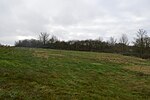St Mary's Church, Fleet Marston
Church of England church buildings in BuckinghamshireChurches preserved by the Churches Conservation TrustEnglish Gothic architecture in BuckinghamshireGrade II* listed churches in BuckinghamshireUse British English from February 2023

St Mary's Church is the redundant Church of England parish church of the deserted medieval village of Fleet Marston, Buckinghamshire, England. It is recorded in the National Heritage List for England as a designated Grade II* listed building, and is under the care of the Churches Conservation Trust. The church stands in a field to the northeast of the A41 road, some 2 miles (3 km) northwest of Aylesbury. John Wesley preached his first sermon in the church soon after he was ordained deacon in September 1725.
Excerpt from the Wikipedia article St Mary's Church, Fleet Marston (License: CC BY-SA 3.0, Authors, Images).St Mary's Church, Fleet Marston
A41,
Geographical coordinates (GPS) Address Nearby Places Show on map
Geographical coordinates (GPS)
| Latitude | Longitude |
|---|---|
| N 51.8369 ° | E -0.8697 ° |
Address
A41
HP18 0PX
England, United Kingdom
Open on Google Maps








